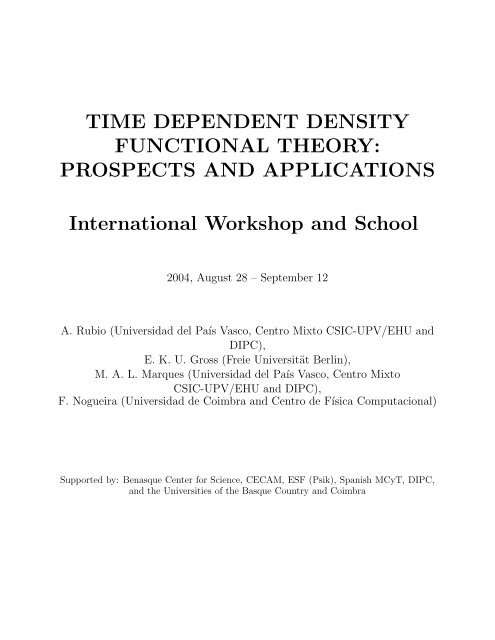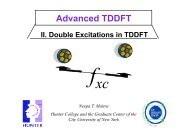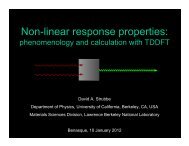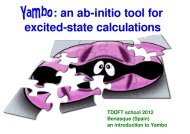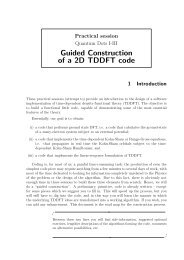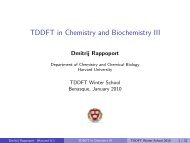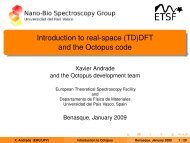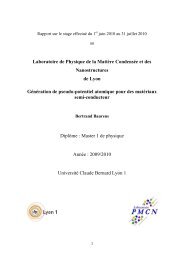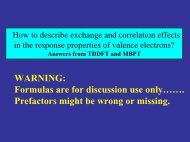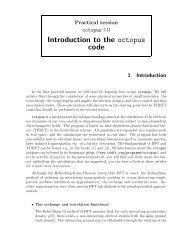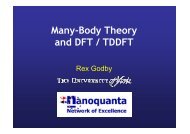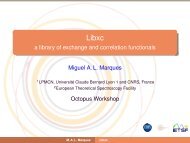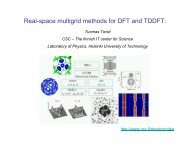TIME DEPENDENT DENSITY FUNCTIONAL THEORY ... - TDDFT.org
TIME DEPENDENT DENSITY FUNCTIONAL THEORY ... - TDDFT.org
TIME DEPENDENT DENSITY FUNCTIONAL THEORY ... - TDDFT.org
- No tags were found...
Create successful ePaper yourself
Turn your PDF publications into a flip-book with our unique Google optimized e-Paper software.
<strong>TIME</strong> <strong>DEPENDENT</strong> <strong>DENSITY</strong><br />
<strong>FUNCTIONAL</strong> <strong>THEORY</strong>:<br />
PROSPECTS AND APPLICATIONS<br />
International Workshop and School<br />
2004, August 28 – September 12<br />
A. Rubio (Universidad del País Vasco, Centro Mixto CSIC-UPV/EHU and<br />
DIPC),<br />
E. K. U. Gross (Freie Universität Berlin),<br />
M. A. L. Marques (Universidad del País Vasco, Centro Mixto<br />
CSIC-UPV/EHU and DIPC),<br />
F. Nogueira (Universidad de Coimbra and Centro de Física Computacional)<br />
Supported by: Benasque Center for Science, CECAM, ESF (Psik), Spanish MCyT, DIPC,<br />
and the Universities of the Basque Country and Coimbra
School Program<br />
time 29/8 30/8 31/8 1/9 2/9 3/9 4/9 5/9 6/9 7/9<br />
10-11.30 DFT1 NUM PP free PROP1+DP APP1 free APP2 BIO1 ALT1<br />
12-13.30 VXC <strong>TDDFT</strong>1 <strong>TDDFT</strong>2 free <strong>TDDFT</strong>3 PROP2 free RT BIO2 ALT2<br />
Lunch<br />
15.30-17 OCT1 OCT3 QD2 free OCT4 PW1 free PW3 QD5 ALT2<br />
17.30-19 OCT2 QD1 QD3 free QD4 PW2 free PW4 PROJ free<br />
21h<br />
School<br />
Dinner<br />
Theoretical Sessions<br />
DFT1 U. von Barth An Introduction to DFT<br />
VXC U. von Barth XC functionals<br />
NUM X. Gonze Numerical methods: plane waves real space methods, etc.<br />
<strong>TDDFT</strong> E.K.U. Gross Time dependent density functional theory<br />
PP X. Gonze Pseudopotentials<br />
PROP A. Castro Propagation schemes (1h45 + 45m)<br />
APP A. Rubio Applications of <strong>TDDFT</strong> for finite and infinite systems<br />
DP V. Olevano Implementation of <strong>TDDFT</strong> for solids (45 m.)<br />
RT<br />
Round table - the past and future of <strong>TDDFT</strong><br />
BIO X. López Biological systems<br />
ALT1 L. Reining <strong>TDDFT</strong> vs BSE<br />
ALT2 G. Vignale <strong>TDDFT</strong> vs CDFT<br />
Practical Sessions<br />
OCT F. Nogueira Finite systems using octopus<br />
QD A. Castro Development of a <strong>TDDFT</strong> program for quantum dots<br />
PW S. Botti, X. Gonze Periodic systems with ABINIT+DP<br />
PROJ<br />
Project<br />
2
Propagators for the time-dependent<br />
Kohn-Sham equations<br />
Alberto Castro<br />
Institut für Theoretische Physik, Freie Universität Berlin, Arnimallee 14, D-14195 Berlin,<br />
Germany<br />
In this lesson we address the problem of the numerical integration of the time- dependent<br />
Schrödinger equation i∂ t ϕ = Ĥϕ. In particular, we are concerned with the important case where<br />
Ĥ is the selfconsistent Kohn-Sham Hamiltonian that stems from time-dependent functional theory.<br />
As the Kohn-Sham potential depends parametrically on the time-dependent density, Ĥ is in general<br />
time-dependent, even in the absence of an external time-dependent field. The present analysis also<br />
holds for the description of the excited state dynamics of a many-electron system under the influence<br />
of arbitraty external time-dependent electromagnetic fields. Our discussion is separated in two<br />
parts: i) First, we look at several algorithms to approximate exp(Â), where  is a time-independent<br />
operator [e.g. Â = −i∆tĤ(τ) for some given time τ]. In particular, polynomial expansions,<br />
projection in Krylov subspaces, and split-operator methods are investigated. ii) We then discuss<br />
different approximations for the time-evolution operator, li ke the mid-point and implicit rules,<br />
and Magnus expansions. Split-operator techniques can also be modified to approximate the full<br />
time-dependent propagator. As the Hamiltonian i s time-dependent, problem ii) is not equivalent<br />
to i). All these techniques have been implemented and tested in our computer code octopus, but<br />
can be of general use in other frameworks and implementations.<br />
3
Numerical methods (I and II)<br />
Xavier Gonze<br />
Louvain la Neuve<br />
We take as starting point the equations of Density-Functional Theory and examine the basic<br />
ideas leading to actual computer programs.<br />
In this respect, one encounters two kinds of high-level problems : (1) mathematical quantities<br />
(like the electronic density or wavefunctions) must be represented by finite sets of numbers ; (2)<br />
mathematical equations must be solved. Supposing a representation, with some inevitable numerical<br />
inaccuracies, algorithms for solving equations will lead to computer predictions, also with a<br />
finite numerical precision. In both cases, the size of the numerical errors must be weighted against<br />
the inherent error present in any approximation to the ”true” DFT. They can be reduced, at the<br />
expense of more memory space or more CPU time. In order to use properly the different computer<br />
programs, the user must be aware of this trade-off.<br />
First, we will focus on the algorithms needed to find the optimized geometry for molecules, clusters<br />
or solids, including the resolution of the Kohn-Sham equations (in order for the electrons to be in<br />
their ground state). The similarities between geometry optimization, Kohn-Sham self-consistency,<br />
and iterative resolution of the Kohn-Sham (or Schroedinger) equation will be highlighted. Basic<br />
iterative methods will be described, as well as more advanced methods like conjugate gradients,<br />
Broyden, and damped dynamics algorithms.<br />
Then, we examine the concept of pseudopotential, a crucial ingredient for several representation<br />
methodologies. Pseudopotentials allow to avoid treating explicitely core electrons. They introduce<br />
quite small errors, compared to the inherent (in)accuracy of present day exchange-correlation functionals.<br />
The freezing of the core electrons will be distinguished from the actual pseudopotential<br />
construction. The historical Kleinman approach will be described, followed by the discussion of<br />
more recent norm-conserving pseudopotentials, and a brief introduction to ultrasoft pseudopotentials,<br />
and projector augmentation.<br />
We will then focus on a particular representation, based on planewaves, well-adapted to the case<br />
of crystalline solids : Bloch theorem, set of planewave coefficients in reciprocal space, Brillouin zone,<br />
computation of the density from wavefunctions, computation of the electrostatic and exchangecorrelation<br />
potential, treatment of metals.<br />
Finally, we present the ABINIT software : availability, structure, features, and present status<br />
of development.<br />
4
Chromophores in biological environments<br />
Xabier López<br />
Kimika Fakultatea; Euskal Herriko Unibertsitatea<br />
An introduction of chromophores in biological environments will be given. Biochromophores<br />
that absorb in the visible lighth mainly consist of phrostehtic groups or cofactors covalently bound<br />
to proteins. In this lecture, we will see some basic examples of these phrostethic <strong>org</strong>anic molecules<br />
and how the absorption of light is coupled with their complex biological functions. In addition,<br />
and since the optical response of these phrosthetic groups is often modulated by their proteic<br />
environment, an introduction to protein structure and its modelization will be given. Finaly, we<br />
discuss some illustrative examples of chromophores emdebbed in proteins and how their optical<br />
absorption is a consequence of both chromophore chemical nature and interaction (structural and<br />
electrostatic) with its proteic surroundings.<br />
5
How to describe exchange and correlation<br />
effects in the response properties of valence<br />
electrons Answers from <strong>TDDFT</strong> and<br />
Many-Boby Perturbation Theory<br />
Lucia Reining<br />
Laboratoire des Solides Irradiés, UMR 7642 CNRS/CEA, École Polytechnique, F-91128<br />
Palaiseau, France<br />
Today, one of the big challenges of theoretical condensed matter physics is to find ways for<br />
describing accurately and efficiently the response of electrons to an external perturbation. In<br />
fact, the knowledge of response functions allows one to directly derive spectra (such as absorption<br />
or electron energy loss); moreover, response functions enter the description of correlation effects,<br />
for example through the screened Coulomb interaction W in Hedin’s GW approximation to the<br />
electron self-energy. Two main developments for the ab initio calculation of response functions of<br />
both finite and infinite systems are, on one side, the solution of the Bethe-Salpeter equation (BSE),<br />
and, on the other hand, Time-Dependent Density Functional Theory (<strong>TDDFT</strong>). Both approaches<br />
are promising, but suffer from different shortcomings: the solution of the Bethe-Salpeter equation is<br />
numerically very demanding, whereas for <strong>TDDFT</strong>, despite recent progress a generally reliable but<br />
at the same time very efficient description of exchange-correlation effects has still to be developed.<br />
Therefore, one would ideally like to combine the advantages of both pictures.<br />
In this lesson, we will show that both approaches can be interpreted as containing the same<br />
physics, but in a different world. We focus on their comparison by putting them on the same<br />
footing. The meaning and importance of different contributions to the induced potentials will be<br />
analyzed. The similarities will allow us to propose combinations of <strong>TDDFT</strong> and the BSE approach<br />
that are leading to a class of exchange-correlation kernels which yield excellent spectra and are<br />
potentially very efficient in numerical calculations.<br />
6
Applications of <strong>TDDFT</strong>: optical absorption<br />
and electron energy loss spectroscopy of<br />
nanostructures and extended systems<br />
Angel Rubio<br />
Departamento de Física de Materiales, Facultad de Química s, UPV/EHU, and Centro Mixto<br />
CSIC-UPV/EHU, 20018 San Sebastián, Spain<br />
In this set of lectures we will present a comparison between <strong>TDDFT</strong> and other approaches for<br />
the description of the response properties of many electron systems [1]. We will provide a short<br />
review of the computational isssues related to the practical implementation of <strong>TDDFT</strong> for finite<br />
and extended systems (within the octopus project [2]). This general scheme allows to treat on<br />
the same footing arbitrary external electromagnetic fields. As application we will show results<br />
for the optical absorption and photoinduced fragmentation of small clusters as well as the photoresponse<br />
of biomolecules (Green-Fluorescent protein and azobencene) [3]. At the end we will<br />
discuss some of the deficiencies of the standard DFT-based approaches to cope with the response<br />
function of extended systems (one, two and three-dimensional) [1]. The problem is traced back<br />
to the lack of long-range interaction in the exchange-correlation kernel. We will show how this<br />
can be incorporated in <strong>TDDFT</strong> by deriving a formally exact exchange-correlation kernel based<br />
on many-body-perturbation theory [4] in connection with Lucia Reining lectures. Also we will<br />
present an alternative, nonperturbative way to treat the electric response of extended systems by<br />
a time-propagation scheme in the same spirit done for nanostructures[2].<br />
Work done in collaboration with M.A.L. Marques, A. Castro, X. Lopez, E.K.U. Gross, D.<br />
Varsano, G. Bertsch, L. Reining, A. Marini, R. Del Sole and G. Onida. We acknowledge support<br />
from the European Community Research Training Network NANOPHASE (HPRN-CT-2000-<br />
00167), Network of Excellence NANOQUANTA (NOE 500198-2), Spanish MCyT(MAT2001-0946)<br />
and the University of the Basque Country (9/UPV 00206.215-13639/2001). The computer time<br />
was granted by DIPC and CEPBA (Barcelona).<br />
[1] G. Onida, L. Reining and A. Rubio, Rev. Mod. Phys. 74, 601 (2002).<br />
[2] M. A. L. Marques, A. Castro, G. F. Bertsch and A. Rubio, Computer Phys. Commun.<br />
151, 60 (2003). The code OCTOPUS is available at http://www.tddft.<strong>org</strong>/programs/octopus. A.<br />
Castro, M.A.L. Marques, J.A. Alonso and A. Rubio Journal of Computational and Theoretical<br />
Nanoscience (in press 2004)<br />
[3] M.A.L Marques, X. López, D. Varsano, A. Castro, and A. Rubio, Phys. Rev. Lett. 90,<br />
258101 (2003); and work to be published for azobencene and DNA basis.<br />
[4]A. Marini, R. Del Sole, and A. Rubio, Phys. Rev. Lett. 91, 256402 (2003); F. Sottile, V.<br />
Olevano and L. Reining, Phys. Rev. Lett. 91, 056402 (2003); L. Reining, V. Olevano, A. Rubio,<br />
and G. Onida, Phys. Rev. Lett. 88, 066404 (2002); R.D. Sole, G. Adragna, V. Olevano and L.<br />
Reining, Phys. Rev. B 67, 045207 (2003).<br />
7
Lectures on <strong>TDDFT</strong> vs CDFT<br />
G. Vignale<br />
Univ. Missouri, USA<br />
1. THE ELASTICITY OF THE ELECTRON LIQUID<br />
In this lecture I review the two classical macroscopic theories of collective dynamics, hydrodynamics<br />
and elasticity, and I show that the usual description of the macroscopic dynamics of an<br />
electron liquid in terms of exchange-correlation fields can be viewed as a combination of these two<br />
theories, where the frequency-dependent visco-elastic coefficients are determined by the quantum<br />
excitation spectrum. Exact results and approximate expressions f or the visco-elastic coefficients<br />
are presented.<br />
2. <strong>TIME</strong>-<strong>DEPENDENT</strong> CURRENT <strong>DENSITY</strong> <strong>FUNCTIONAL</strong> <strong>THEORY</strong><br />
Here I show how the results obtained for the homogeneous electron liquid can be used to construct<br />
a local approximation for the exchange-correlation potential for non-homogeneous electronic<br />
systems. Such a construction must be done within the framework of the current-density functional<br />
theory (CDFT), in which the basic variable is the current density, an d the exchange-correlation<br />
effects are described in terms of a vector potential. The explicit form of the exchange correlation<br />
potential beyond the adiabatic local density approximation is then discussed.<br />
8
Workshop<br />
Day I: Wednesday 8th<br />
09h00 - 09h10 Angel Rubio Opening remarks<br />
09h10 - 10h00 Robert van Leeuwen An overview of basic concepts in <strong>TDDFT</strong><br />
and some new extensions<br />
10h00 - 10h50 Ilya Tokatly Quantum many-body dynamics in Lagrangian frame:<br />
Geometric formulation of <strong>TDDFT</strong><br />
10h50 - 11h20<br />
Caffeine break<br />
11h20 - 12h10 Neepa Maitra Aspects of non-adiabaticity in <strong>TDDFT</strong><br />
12h10 - 13h00 Shaul Mukamel Spontaneous Density Fluctuations, Intermolecular Forces<br />
and Nonlinear <strong>TDDFT</strong> Response;<br />
Superoperator Approach<br />
13h00 - 15h00<br />
Lunch break<br />
15h00 - 15h50 Juerg Hutter Plane-wave <strong>TDDFT</strong> calculations of molecules in solution<br />
15h50 - 16h40 Michiel Sprik Car-Parrinello <strong>TDDFT</strong> computation of electronic spectra<br />
of some transition metal aqua ions in solution<br />
16h40 - 17h10<br />
Beer break<br />
17h10 - 18h00 Yoshiyuki Miyamoto Excited State Molecular Dynamics with use of the<br />
code FPSEID: First Principles Simulation tool for<br />
Electron Ion Dynamics<br />
18h00 - 19h00<br />
Poster Session<br />
Day II: Thursday 9th<br />
09h10 - 10h00 Giovanni Vignale Advances in time-dependent spin density functional theory<br />
10h00 - 10h50 Roi Baer Time dependent density functional theory:<br />
new functionals and applications<br />
10h50 - 11h20<br />
Caffeine break<br />
11h20 - 12h10 Tuomas Torsti Real-space multigrid methods for DFT and <strong>TDDFT</strong><br />
12h10 - 13h00 M. Marques Octopus: present, past, and future<br />
13h00 - 15h00<br />
Lunch break<br />
15h00 - 15h50 Raffaele Resta Localization and polarization in the insulating state of matter<br />
15h50 - 16h40 I. Tavernelli Excited state ab initio MD of photochemical processes in model compou<br />
16h40 - 17h10<br />
Beer break<br />
17h10 - 18h00 Giacomo Mulas Using ab initio tools to solve the astrophysical puzzle<br />
of interstellar PAHs<br />
9
Day III: Friday 10th<br />
09h10 - 10h00 Kieron Burke Rigorous DFT treatment of transport through<br />
single molecules<br />
10h00 - 10h50 Roberto Car Electron transport and dissipation in nanoscale devices<br />
10h50 - 11h20<br />
Caffeine break<br />
11h20 - 12h10 Carl-Olof Almblahd Time-dependent quantum transport by means of <strong>TDDFT</strong><br />
12h10 - 13h00 Rex Godby Self-Energy Approaches for Excited and Ground States:<br />
Lessons for and from DFT<br />
13h00 - 15h00<br />
Lunch break<br />
15h00 - 15h50 Martin Fuchs Use of the the adiabatic-connection<br />
fluctuation-dissipation approach<br />
to exchange-correlation in the ground state<br />
15h50 - 16h40 P. Garcia Gonzalez TD-DFT as an useful tool to calcute accurate<br />
correlation energies<br />
16h40 - 17h10<br />
Beer break<br />
17h10 - 18h00<br />
Presentations from the best posters.<br />
Day IV: Saturday 11th<br />
09h10 - 10h00 Andreas Goerling Exact-exchange <strong>TDDFT</strong> methods for molecules and solids<br />
10h00 - 10h50 P. de Boeij The time-dependent current-functional approach<br />
for the response of solids and polymers<br />
10h50 - 11h20<br />
Caffeine break<br />
11h20 - 12h10 Lucia Reining <strong>TDDFT</strong> and Many-Boby Perturbation Theory:<br />
comparisons and combinations<br />
12h10 - 15h00<br />
Lunch break<br />
15h00 - 17h30<br />
Discussions<br />
17h30 - 17h45 E.K.U. Gross Closing remarks<br />
10
Time-dependent quantum transport by<br />
means of <strong>TDDFT</strong><br />
Gianluca Stefanucci and Carl-Olof Almbladh<br />
Department of Theoretical Physics, University of Lund, Lund, Sweden<br />
An exact theoretical framework based on Time Dependent Density Functional Theory (<strong>TDDFT</strong>)<br />
is proposed in order to deal with the time-dependent quantum transport in fully interacting systems.<br />
We use a partition-free approach by Cini in which the whole system is in equilibrium before an<br />
external electric field is switched on. Our theory includes the interactions between the leads and<br />
between the leads and the device. It is well suited for calculating measurable transient phenomena<br />
as well as a.c. and other time-dependent responses and is valid for finite as well as macroscopic<br />
electrodes. We show that the steady-state current results from a dephasing mechanism provided<br />
the leads are macroscopic and the device is finite. In the d.c. case, we obtain a Landauer-like<br />
formula when the effective potential of <strong>TDDFT</strong> is uniform deep inside the electrodes.<br />
11
The time-dependent current-functional<br />
approach for the response of solids and<br />
polymers’<br />
Paul L. de Boeij<br />
Groningen, The Netherlands<br />
The first-principles description of the response of crystalline systems to external fields relies<br />
heavily on the use of periodic boundary conditions. This treatment has important implications for<br />
the time-dependent density functional framework. I will show how intrinsic, i.e. material properties<br />
can be obtained and how extrinsic, i.e. size and shape dependent effects can effectively be removed<br />
from the computational scheme. The result of this analysis is that a uniform component of the<br />
current-density appears as an extra degree of freedom, which is not uniquely fixed by the lattice<br />
periodic density. A natural way to treat the periodic systems is now obtained by changing the basic<br />
dynamical variable from the time-dependent density to the induced current-density. Observable<br />
quantities, like for instance the induced macroscopic polarization can then be given in closed form<br />
as current functionals. The response to both longitudinal and transverse fields can be treated in<br />
this unified approach. I will give the linear response and excitation formulation for the resulting<br />
time-dependent Kohn-Sham system, and show how (non)-adiabatic density and current-density<br />
dependent exchange-correlation functionals are included. The approach is equally well suitable to<br />
treat finite systems as infinite metallic or insulating systems. I apply the time-dependent currentdensity<br />
functional approach to the response properties of periodic systems and finite systems. The<br />
periodic structures include several (semi)metallic and semiconducting crystals and polymers. The<br />
finite systems cover several pi-conjugated and non-conjugated oligomers and small molecules. In<br />
these systems some failures of the ALDA are discussed and results are presented for the currentdensity<br />
dependent exchange-correlation functional derived by Vignale and Kohn. The influence<br />
of this functional on the linear response and excitation energies is discussed. For the oligomer<br />
polarizabilities the asymptotic relation to the polymer susceptibilities is discussed.<br />
12
Rigorous DFT treatment of transport<br />
through single molecules<br />
Kieron Burke<br />
Dept of Chemistry and Chemical Biology, Rutgers University<br />
Transport through single molecules has become a hot topic since the first experiments several<br />
years ago. But it is unclear if the present methodology (Landauer formalism plus ground-state DFT)<br />
is the correct approach for calculating conductance in these devices. I’ll discuss the problems, and<br />
show some recent results in the weak bias limit, derived using <strong>TDDFT</strong>. I’ll also discuss a new<br />
methodology for handling dissipation in electronic systems using a Kohn-Sham master equation.<br />
13
Electron transport and dissipation in<br />
nanoscale devices<br />
Roberto Car<br />
Princeton University, Princeton, NJ08544, USA<br />
We present a quantum-kinetic scheme for the calculation of non-equilibrium transport properties<br />
in nanoscale systems. Our approach is based on a time-dependent Kohn-Sham master equation for<br />
the reduced electronic density operator and represents a generalization of the well-known Boltzmann<br />
kinetic equation. The approach allows us, in particular, to model transport situations under high<br />
applied fields by adopting periodic boundary conditions. Applications to nanoscale devices and<br />
molecular structures are discussed<br />
14
The time-dependent current-functional<br />
approach for the response of solids and<br />
polymers<br />
Paul L. de Boeij<br />
Groningen, The Netherlands<br />
The first-principles description of the response of crystalline systems to external fields relies<br />
heavily on the use of periodic boundary conditions. This treatment has important implications for<br />
the time-dependent density functional framework. I will show how intrinsic, i.e. material properties<br />
can be obtained and how extrinsic, i.e. size and shape dependent effects can effectively be removed<br />
from the computational scheme. The result of this analysis is that a uniform component of the<br />
current-density appears as an extra degree of freedom, which is not uniquely fixed by the lattice<br />
periodic density. A natural way to treat the periodic systems is now obtained by changing the basic<br />
dynamical variable from the time-dependent density to the induced current-density. Observable<br />
quantities, like for instance the induced macroscopic polarization can then be given in closed form<br />
as current functionals. The response to both longitudinal and transverse fields can be treated in<br />
this unified approach. I will give the linear response and excitation formulation for the resulting<br />
time-dependent Kohn-Sham system, and show how (non)-adiabatic density and current-density<br />
dependent exchange-correlation functionals are included. The approach is equally well suitable to<br />
treat finite systems as infinite metallic or insulating systems. I apply the time-dependent currentdensity<br />
functional approach to the response properties of periodic systems and finite systems. The<br />
periodic structures include several (semi)metallic and semiconducting crystals and polymers. The<br />
finite systems cover several pi-conjugated and non-conjugated oligomers and small molecules. In<br />
these systems some failures of the ALDA are discussed and results are presented for the currentdensity<br />
dependent exchange-correlation functional derived by Vignale and Kohn. The influence<br />
of this functional on the linear response and excitation energies is discussed. For the oligomer<br />
polarizabilities the asymptotic relation to the polymer susceptibilities is discussed.<br />
15
Use of the adiabatic-connection<br />
fluctuation-dissipation approach to<br />
exchange-correlation in the ground state<br />
Martin Fuchs<br />
Fritz-Haber-Institut der Max-Planck-Gesellschaft, Berlin, Germany<br />
The adiabatic-connection fluctuation-dissipation theorem (ACFDT) provides an exact formula<br />
for the exchange-correlation (XC) energy in terms of the dynamical linear density-density response<br />
function, a quantity given by time-dependent density-functional theory. Approximate “ACFDT”<br />
XC functionals may be generated from suitable response functions, opening the way for improvements<br />
beyond present functionals such as the LDA, GGA, or hybrids: (i) proper treatment of van<br />
der Waals interactions, and (ii) systematically higher accuracy for the bond energetics of molecules<br />
and solids.<br />
Here we consider ACFDT XC functionals based on the random phase approximation (RPA)<br />
alone and the RPA augmented by an (approximate) exchange kernel (RPA+X), which we have<br />
recently implemented in a pseudopotential plane-wave framework [1,2]. Calculating the groundstate<br />
potential energy curves for H 2 and Be 2 , we find that the RPA gives excellent results for the binding<br />
energy, equilibrium bond length and fundamental vibrational frequency. Considering stretched H 2 ,<br />
we show that the RPA largely overcomes the long-standing symmetry dilemma of DFT: the molecule<br />
dissociates properly into two atoms without taking recourse to artificial symmetry breaking as in the<br />
usually applied spin-unrestricted Kohn-Sham schemes. The RPA thus captures the strong static<br />
(left-right) correlations when the bond breaks, as is apparent from the corresponding adiabatic<br />
connection curves. At intermediate bond lengths, the RPA as well as the RPA+X potential energy<br />
curves remain too repulsive however. We discuss implications of this finding on the construction<br />
TD-DFT XC kernels for ACFDT XC functionals beyond the RPA.<br />
[1] M. Fuchs and X. Gonze, Phys. Rev. B 65, 235109 (2002); M. Fuchs, K. Burke, Y.-M. Niquet,<br />
and X. Gonze, Phys. Rev. Lett. 90, 189701 (2003).<br />
[2] X. Gonze et al., Comput. Materials Science 24, 478 (2002).<br />
work performed with Yann-Michel Niquet (SP2M/L Sim, CEA Grenoble, France), Kieron Burke<br />
(Dept. of Chemistry and Chemical Biology, Rutgers Univ., U.S.), and Xavier Gonze (Unite PCPM,<br />
Univ. Catholique de Louvain, Belgium).<br />
16
Exact-exchange <strong>TDDFT</strong> methods for<br />
molecules and solids<br />
Andreas Goerling<br />
Bonn University<br />
The Kohn-Sham formalism is reconsidered in order to introduce the concept of orbital-dependent<br />
functionals for exchange-correlation energies, potentials, and kernels. Adiabatic connection perturbation<br />
theory for a systematic construction of functionals in the static as well as in the timedependent<br />
case is discussed. Response properties (excitation energies, NMR chemical shifts) of<br />
molecules based on effective exact-exchange KS orbitals and eigenvalues are presented. An exactexchange<br />
<strong>TDDFT</strong> approach for solids is presented and compared to methods based on the Bethe-<br />
Salpeter equation.<br />
17
TD-DFT as an useful tool to calcute accurate<br />
correlation energies<br />
P. Garcia-Gonzalez (1), J. Jung (1), A. Marini (2), J. Dobson (3), R.W.<br />
Godby (4), and A. Rubio (2)<br />
(1) Departamento de Fisica Fundamental, UNED, Apartado 60.149, E-28080 Madrid, Spain<br />
(2) Donostia International Physics Center, Apartado 1072, E-20018 San Sebastian, Spain<br />
(3) School of Science, Griffith University, Nathan, Queensland 4111, Australia<br />
(4) Department of Physics, University of York, Heslington, York YO10 5DD, United Kingdom<br />
The adiabatic-connection fluctuation-dissipation theorem (ACFDT) in the framework of Time<br />
Dependent Density Functional Theory (TD-DFT) has emerged as a promising alterative to standard<br />
implementations of Kohn-Sham (KS) theory to calculate correlation energies. In this approach, the<br />
correlation energy is calculated from the knowledge of the interacting density response, without<br />
resorting to mean-field-like approximations. Thus, using the ACFDT scheme we can easily describe<br />
many-body effects that are absent in the KS-LDA or KS-GGA without the numerical expense of<br />
diffusion quantum Monte Carlo calculations.<br />
If we neglect local-field corrections in the construction of the density response, it is well known<br />
that the absolute correlation energies so obtained are not accurate at all. Nonetheless, it is believed<br />
that even at this RPA level, the ”binding” correlation energies are very accurate. To confirm this<br />
trend, we have calculated the RPA energies of model jellium-like systems as well as the structural<br />
properties of simple solids (Si, NaCl), where the KS-LDA performs quite well. As expected, there<br />
are minor differences between the KS-LDA and the RPA results. However, in model layered systems,<br />
where layer-layer interactions are very weak, there are evident discrepancies between the KS and<br />
the TD-DFT binding energies. This is due to the presence of long-ranged correlations that cannot<br />
be described at all by mean-field approximations.<br />
In the ACFDT framework, local-field corrections mainly account for short-ranged electronelectron<br />
correlations. They can be built in either through LDA/GGA functionals or by including<br />
non-local XC kernels in the evaluation of the density response. Since we are interested on correlation<br />
energies, both corrections are constructed by imposing the reproduction of the exact homogeneous<br />
electron gas energies. We will see that these procedures are very robust, since the corrected correlation<br />
energies are rather insensitive to the details of the method used to implement the local-field<br />
corrections. The comparison with the corresponding RPA energies suggests that the RPA slightly<br />
overcorrects the KS-LDA results.<br />
18
Self-Energy Approaches for Excited and<br />
Ground States: Lessons for and from DFT<br />
Rex Godby<br />
Department of Physics, University of York, Heslington, York YO10 5DD, United Kingdom<br />
Density-functional theory was originally a theory for the ground-state total energy which more<br />
recently, through <strong>TDDFT</strong>, has been applied to calculations of certain excited-state properties. On<br />
the other hand, self-energy approaches (within the framework of many-body perturbation theory)<br />
are theories of the one-electron Green’s function which is most directly related to spectral properties<br />
such as quasiparticle energies and lifetimes for added electrons or holes, but can also be applied to<br />
the calculation of ground-state properties such as the total energy.<br />
In situations where both methods are applicable, each has advantages and disadvantages.<br />
(TD)DFT is typically inexpensive, but in systems where electronic exchange and correlation has<br />
more than a peripheral role, the uncontrolled (and sometimes quite pathological) errors in the usual<br />
density-based exchange-correlation functionals (such as the LDA and GGA) limit its applicability.<br />
Ab initio many-body perturbation theory provides, in principle, a convergable series of successive<br />
approximations to the exact answer, but the numerical complexity in practice restricts its application<br />
to relatively low-order approximations such as the GW approximation, which is the first-order<br />
term in an expansion of the self-energy operator Σ in powers of the dynamically screened electronelectron<br />
interaction, W . It may be thought of as exact exchange (the Hartree-Fock exchange<br />
operator), together with an partial inclusion of correlation diagrams through dynamical screening<br />
of the Coulomb interaction. From Σ, the one-electron Green’s function G may be calculated, from<br />
which various spectral and ground-state properties are available. For transport properties (as well<br />
as certain other excited-state properties), the two-electron Green’s function is required, which may<br />
also be formulated at the same level of approximation as GW .<br />
By way of introduction to GW , I shall give a brief review of key applications to spectral<br />
properties such as quasiparticle energies and lifetimes for added electrons or holes.<br />
In applying GW to the ground-state total energy, the choice of whether G and/or W are made<br />
to be consistent with the Green’s function that arises from Σ is particularly important: G 0 W 0 ,<br />
GW 0 and fully self-consistent GW , where G 0 generally indicates the LDA Green’s function. I<br />
shall present results for finite and infinite systems at all three levels of self-consistency. These<br />
include converged results resulting from the incorporation of self-consistency and GW total-energy<br />
techniques into our general-purpose GWST “space-time” supercell code suite [1], which interfaces<br />
with pseudopotential plane-wave DFT calculations as its input. This allows the extension of the<br />
GW total-energy approach from high-symmetry test systems [2] to general systems, and opens the<br />
possibility of applications to systems whose energetics is not described sufficiently reliably within<br />
the usual DFT-based approaches.<br />
I shall also describe our recent formulation [3] of the conductance of a junction between two<br />
nanowires in a form which permits the inclusion of electronic correlation effects in a GW -like<br />
framework.<br />
[1] “Space-time method for ab initio calculations of self-energies and dielectric response functions<br />
of s olids”, H. N. Rojas, R. W. Godby and R. J. Needs, Phys. Rev. Lett. 74 1827 (1995)<br />
[2] “Many-body GW calculations of ground-state properties: quasi-2D electron systems and van<br />
der Waals fo rces”, P. García-González and R. W. Godby, Phys. Rev. Lett. 88 056406 (2002)<br />
19
[3] “Conductance and polarization in quantum junctions”, P. Bokes and R.W. Godby, Phys. Rev.<br />
B 69 245420 (2004)<br />
Further details at http://www-users.york.ac.uk/∼rwg3/.<br />
20
Plane-wave <strong>TDDFT</strong> calculations of molecules<br />
in solution<br />
Juerg Hutter<br />
Physical Chemistry Institute, University of Zurich<br />
A formulation of time dependent linear response density functional theory within the planewave<br />
pseudopotential framework has recently been introduced [J. Hutter, J. Chem. Phys., 118,<br />
3928 (2003)]. This implementation allows for efficient calculations of excitation spectra, excited<br />
state properties and coupling to classical force fields in QM/MM approaches. The scheme has<br />
been applied in combination with Car-Parrinello molecular dynamics to study the solvent shift<br />
and intensity enhancement effects of the first electronic transition in acetone-water systems [L.<br />
Bernasconi et al., J. Chem. Phys., 119, 12417 (2003)]. In agreement with experiment a general<br />
increase in the mean oscillator strength and a blue shift of 0.19 eV of the transition was found.<br />
However, this analysis was severely hampered by shortcomings of traditional density functionals.<br />
Both, the poor eigenvalues of occupied and virtual Kohn-Sham orbitals and the lack of a correct<br />
representation of charge transfer (CT) in the response kernel result in many unphysical solutesolvent<br />
and solute-solute CT states overlapping with the acetone n-¿π ∗ transition. These problems<br />
are partially solved using hybrid functional, although only with drastically increased computational<br />
costs [L. Bernasconi et al., Chem. Phys. Lett., 394, 141 (2004)]. Another approach combines<br />
standard DFT calculations with <strong>TDDFT</strong> using the statistical average of orbital model exchangecorrelation<br />
potentials. The improved representation of orbital energies helps to isolate low-lying<br />
local transitions and is a first step towards an accurate description of CT states.<br />
21
Aspects of non-adiabaticity in <strong>TDDFT</strong><br />
Neepa Maitra<br />
Department of Physics and Astronomy Hunter College and City University of New York<br />
Memory is a feature of time-dependent density functionals that is well-known to exist but little<br />
understood. Indeed, the vast majority of <strong>TDDFT</strong> calculations utilise adiabatic approximations,<br />
where memory is entirely neglected. In this talk, I review some formal aspects of memory in<br />
<strong>TDDFT</strong>, and point out its significance in quantum control problems. I shall discuss some applications<br />
in linear response where non-adiabaticity plays a prominent role; these include the description<br />
of states of significant double excitation character and long-range charge transfer states.<br />
22
Octopus: present, past, and future<br />
M. A. L. Marques<br />
Departamento de Física de Materiales, Facultad de Químicas, Universidad del País Vasco, Centro<br />
Mixto CSIC-UPV/EHU and Donostia International Physics Center (DIPC), 20080 San Sebastián,<br />
Spain<br />
We present a computer package aimed at the simulation of the electron-ion dynamics of finite<br />
systems, both in one and three dimensions, under the influence of time-dependent electromagnetic<br />
fields. The electronic degrees of freedom are treated quantum mechanically within the<br />
time-dependent Kohn-Sham formalism, while the ions are handled classically. All quantities are<br />
expanded in a regular mesh in real space, and the simulations are performed in real time. Although<br />
not optimized for that purpose, the program is also able to obtain static properties like ground-state<br />
geometries, or static polarizabilities. The method employed proved quite reliable and general, and<br />
has been successfully used to calculate linear and non-linear absorption spectra, harmonic spectra,<br />
laser induced fragmentation, etc. of a variety of systems, from small clusters to medium sized<br />
quantum dots.<br />
23
⋆ Excited State Molecular Dynamics with use<br />
of the code FPSEID: First Principles<br />
Simulation tool for Electron Ion Dynamics<br />
Yoshiyuki Miyamoto ⋆ and Osamu Sugino †<br />
† Fundamental and Environmental Research Labs. NEC<br />
Institute for Solid State Physics, University of Tokyo<br />
In this talk, I will give molecular dynamics (MD) simulations on the adiabatic potential energy<br />
surfaces of electronic excited states. In these MD simulations, adiabatic approximation for<br />
the exchange-correlation potential is adopted, and the excitation is simply mimicked by manually<br />
promoted electronic occupations. Even with this simplified approximation, the time-dependent<br />
treatment for the Kohn-Sham equation is necessary to follow the right potential energy surface.<br />
Numerical stability for simulation-time beyond hundreds femtoseconds and difficulty in treating<br />
non-adiabatic (nonradiative) decay of excitation will be discussed. The applications are MD simulations<br />
on photo-excited carbon nanotubes, which will be related to nanotube engineering.<br />
This work has been done in collaborations with Profs. Angel Rubio and David Tománek. Part<br />
of present works were supported by the Earth Simulator Center and by NAREGI Nanoscience<br />
Project, Ministry of Education, Culture, Sports, Science and Technology, Japan.<br />
24
Spontaneous Density Fluctuations,<br />
Intermolecular Forces and Nonlinear <strong>TDDFT</strong><br />
Response; Superoperator Approach<br />
Shaul Mukamel<br />
University of California, Irvine, CA 92697-2025<br />
Dispersive long-range forces are ubiquitous in nature and have been the subject of intense experimental<br />
and theoretical attention [1-3]. van der Waals (vdW), non-bonded interactions between<br />
neutral, polarizable molecules that play an important role in many chemical and biological dynamical<br />
processes. vdW forces may be computed using the nonlocal linear polarizabilities or charge<br />
response functions of the individual molecules [4]. By formulating quantum dynamics in terms of<br />
superoperators in Liouville space [3] intermolecular forces may be expressed to all orders in terms of<br />
both the charge density response and the spontaneous charge fluctuations of individual molecules.<br />
The building blocks of the p’th order response are 2p, (p + 1)- point correlation functions of the<br />
charge density which differ by permutations of their time arguments. Each correlation function<br />
represents a Liouville Space pathway for the density matrix [5]. A complete description of intermolecular<br />
forces requires a set of p+1 combinations of these pathways denoted generalized response<br />
functions (GRF) [6]. The p’th order polarizability is only one member of that family. Using a superoperator<br />
formulation of <strong>TDDFT</strong> [7,8,9], we calculate the GRFs of individual molecule which,in<br />
turn, are evaluated using the collective electronic oscillator (CEO) eigenmodes of the linearized<br />
<strong>TDDFT</strong> .These GRFs are used to compute the intermolecular energy in terms of CEO modes[10].<br />
The ”causality” paradox” [11] of the <strong>TDDFT</strong> response is naturally reolved by the non-retarded<br />
supreroperator formalism. In Liouville space all physical observables can be expressed in terms<br />
of positively ordered products of superoperators avoiding the negative time ordering required for<br />
ordinary operators in Hilbert space (the Keldysh loop). Non-equlibrium Greens functions may thus<br />
be evaluated in real (physical) time.<br />
[1] W. Kohn, Y. Meir and D. E. Makarov, Phys. Rev. Lett. 80, 4153 (1998).<br />
[2] M. Lein, J. F. Dobson and E. K. U. Gross, J. Computational Chem. 20, 12(1999).<br />
[3] S. Tsuzuki, K. Honda, T. Uchimaru, M. Mikami and K. Tanabe, J. Am. Chem. Soc. 124,<br />
104 (2002).<br />
[4] A. D. McLachlan, Proc. R. Soc. London A 271, 387 (1963); 274, 80 (1963).<br />
[5] S. Mukamel “Principles of Nonlinear Optical Spectroscopy”, (Oxford Univ. Press, New York,<br />
1995).<br />
[6] A. E. Cohen and S. Mukamel, Phys. Rev. Lett. 91, 233202 (2003).<br />
[7] O. Berman and S. Mukamel, Phys. Rev. A 67, 042503 (2003).<br />
[8] V. Chernyak and S. Mukamel, J. Chem. Phys. 104, 444 (1996).<br />
[9] S. Tretiak and S. Mukamel, Chem.. Rev. 102, 3171 (2002).<br />
[10] U. Harbola and S. Mukamel, “Intermolecular Forces and Non-Bonded Interactions: Superoperator<br />
Nonlinear <strong>TDDFT</strong> Response Approach”, Phys. Rev. A (In press) (2004).<br />
[11] E. K. U. Gross, J. F. Dobson and M. Petersilka, Density Functional Theory, edited by R.<br />
F. Nalewajski (Springer, New York, 1996).<br />
[12] S. Mukamel, “Generalized <strong>TDDFT</strong> Response Functions for Spontaneous Density Fluctuations<br />
and Nonlinear Response: Resolving the Causality Paradox in Real Time” (in preparation)<br />
(2004).<br />
25
Using ab initio tools to solve the<br />
astrophysical puzzle of interstellar PAHs<br />
Giacomo Mulas and Giuliano Malloci<br />
Cagliari, Italy<br />
The presence of a large amount of gas-phase Polycyclic Aromatic Hydrocarbons (PAHs) in the<br />
InterStellar Medium (ISM) of our galaxy was suggested about twenty years ago (Léger & Puget,<br />
1984; Allamandola et al., 1985), to account for the ubiquitous infrared emission bands near 3.3, 6.2,<br />
7.7, 8.6, 11.3 and 12.7 micrometers seen wherever dusty environments are excited by UV photons. In<br />
the last two decades this ”PAH hypothesis” was the subject of intensive study, and these molecules<br />
and their derivatives were speculated to also give rise to other unidentified interstellar spectral<br />
features: the Diffuse Interstellar Bands (a set of 300 absorption features throughout the visible)<br />
and the far-UV rise of the interstellar extinction curve, just to name two of the most outstanding<br />
puzzles in the spectroscopy of the interstellar medium. Nonetheless, no single PAH has been<br />
identified to date in astronomical spectra.<br />
Since a large scale, systematic experimental study of the whole family of PAHs and derivatives<br />
in conditions comparable to those in the ISM would be a hopelessly demanding task, we are using<br />
(TD)DFT techniques, together with a Monte Carlo model of the photophysics of interstellar PAHs,<br />
to prepare an atlas of their computed interstellar spectra, for direct comparison with astronomical<br />
data and as a guide for targeted experimental measures on specific molecules, which would say the<br />
final word. We here present some preliminary results of this ongoing effort.<br />
26
Localization and polarization in the insulating<br />
state of matter<br />
Raffaele Resta<br />
INFM DEMOCRITOS National Simulation Center, Trieste, and Dipartimento di Fisica Teorica,<br />
University of Trieste<br />
At variance with what happens in metals, the electronic charge in insulators cannot flow freely<br />
under an applied dc field, and undergoes instead static polarization. Both these features owe to the<br />
different nature of the excitation spectrum, but also to a different <strong>org</strong>anization of the electrons in<br />
their ground state: electrons are localized in insulators and delocalized in metals. Such localization<br />
feature, however, is hidden in a rather subtle way into the many-body wavefunction. There have<br />
been recent advances in the theory of the insulating state, which in turn are deeply rooted into<br />
the modern theory of polarization, based on a Berry phase. Localization and polarization can be<br />
regarded as two aspects of the same phenomenon, and stem from essentially the same formalism.<br />
The theory is very general, and applies on the same footing to either correlated wavefunctions<br />
or independent electrons, and to either disordered or crystalline systems. Its implications for a<br />
Kohn-Sham crystal can be stated as follows. In insulators, a set of well localized orbitals (the<br />
Wannier functions) spans the same Hilbert space as do the Bloch orbitals of the occupied bands.<br />
The first moment (dipole) of these orbitals defines macroscopic polarization, while their spherical<br />
second moment (spread) can be made finite. In metals macroscopic polarization is ill-defined, while<br />
it is impossible to span the Hilbert space of the occupied Bloch states using localized orbitals whose<br />
spread is finite.<br />
27
Car-Parrinello <strong>TDDFT</strong> computation of<br />
electronic spectra of some transition metal<br />
aqua ions in solution<br />
Leonardo Bernasconi, Michiel Sprik, and Jürg Hutter<br />
Department of Chemistry, University of Cambridge, UK<br />
Department of Chemistry, University of Zurich, Switzerland<br />
Transition metal complexes show a variety of electronic excitations often observable as absorption<br />
of light in the visible range. These transitions can be broadly divided into d → d excitations<br />
(largely metal → metal), charge transfers between ligands and metal and d → s transitions. Using<br />
the time dependent density functional response theory method as implemented in the CPMD<br />
code[1,2], we have studied the electronic absorption spectrum of Ru 2+ (H 2 O) 6 , as an example of<br />
d → d transitions and Ag + and Cu + as examples of d → s transitions. The result of the finite<br />
temperature t 6 2g → t 5 2g e1 g (visible) absorption spectrum of Ru2+ (H 2 O) 6<br />
at the BLYP level of theory<br />
was found in good agreement with experiment including the splitting between the 1 T 2g and 1 T 1g<br />
terms due to electronic repulsion. Apart from minor changes in intensities we found little difference<br />
between the vacuum spectrum of the hexahydrate and the spectrum in bulk aqueous solution. The<br />
computed UV spectrum of Ag + , while red shifted w.r.t to experiment by 2 eV, shows a line shape<br />
in fair agreement with experiment. Our calculations suggest that the observed three peak structure<br />
is consistent with a dihedrally distorted fourfold coordination[3]. Similar to our previous calculation<br />
of the spectrum of aqueous acetone[2,4], the Ru 2+ (H 2 O) 6<br />
spectrum shows spurious solvent<br />
→ solute and solute → solvent charge transfer excitations, which can be eliminated by switching<br />
over (at considerable computational cost) to a density functional which includes a fraction of exact<br />
exchange (PBE0). This also essentially cures the 2 eV redshift of the position of the Ag + absorption<br />
band, which because of the highly delocalized nature of the 5s state in solution can be considered<br />
as a manifestation of the well known underestimation of band gaps in DFT. Our calculations seem<br />
to confirm therefore the importance of exact exchange for the computation of excitation spectra in<br />
condensed molecular systems. Finally we will present our first results on the emission spectrum of<br />
Ru 2+ (H 2 O) 6<br />
obtained by a molecular dynamics simulation on the energy surface associated with<br />
the lowest t 6 2g → t 5 2g e1 g excitation with special attention to solvent effects on the Stokes shift.<br />
28
Excited state ab initio MD of photochemical<br />
processes in model compounds<br />
Ivano Tavernelli, Enrico Tapavicza, Ute Röhrig, Ursula Röthlisberger<br />
Swiss Federal Institute of Technology, EPFL, CH-1015 Lausanne, Switzerland<br />
This talk will focus on two photochemical processes of chemical and biological relevance, namely<br />
photo-isomerisation and photoinduced electron transfer. Our computational approach is based on<br />
the implementation of time-dependent density functional theory [1] (<strong>TDDFT</strong>) in the ab initio MD<br />
code CPMD [2]. Recently, the possibility to compute excited state properties within a mixed<br />
quantum-classical (QM/MM) [3] scheme was included. This gives us the opportunity to study for<br />
the first time ET processes in large molecular systems in different complex environments.<br />
Photo-isomerisation. Photoinduced cis-trans isomerisations of C=C, C=N and N=N double<br />
bonds are investigated in three model compounds, namely the 2,4-pentadiene-1-iminium cation<br />
(PSB), formaldimine, and diimide. For formaldimine and diimide, the results obtained using<br />
<strong>TDDFT</strong> are in agreement with experimental data and previously reported theoretical results. The<br />
molecular dynamics simulations yield new insights into the relaxation pathways in the excited state.<br />
For PSB, which is a model system for the retinal protonated Schiff base involved in the visual process,<br />
the forces computed from the LR-<strong>TDDFT</strong> S 1 surface do not lead to double bond isomerisation<br />
but to single bond rotation [4]. The same reaction was also observed for the case of photoexcited<br />
retinal in its protein environment.<br />
Phoinduced electron transfer. Electron transfer is an important chemical process with applications<br />
in physics, chemistry and biology. ET in molecular systems is characterized by a spontaneous<br />
charge redistribution between an initially prepared reactant state and a well defined product<br />
state. It is usually described as the transport of a single electron from a donor (D) molecular<br />
orbital (MO) to an acceptor (A) MO even though all MO of the system are modified during the<br />
transition. Because of its intrinsic properties, namely charge separation and orbital re<strong>org</strong>anization,<br />
ET processes constitute a major challenge for modern DFT studies.<br />
In the case of intramolecular photoinduced ET, the reactant state is obtained after optical excitation<br />
of an electron from the ground state into one of its excited states. The ET process proceeds<br />
then through a rearrangement of the nuclear coordinates together with the relaxation of the excited<br />
electron into the LUMO (lowest unoccupied molecular orbital) on the acceptor site. In the present<br />
work we investigate using ab initio molecular dynamics (MD) methods the orbital and nuclear<br />
rearrangements that follow the electronic vertical photo-excitation of small <strong>org</strong>anic molecules. Of<br />
particular interest is the analysis of the dependence of electronic and nuclear rearrangements on<br />
the spacing between donor and acceptor moieties (obtained by adding a number of bridge units)<br />
and on the screening effects induced by solvents with different polarity.<br />
[1] E. Runge and E.K.U. Gross, Rhys. Rev. Lett. 52, 997 (1984),<br />
J. Hutter, J. Chem. Phys. 118, 3928 (2003)<br />
[2] Car-Parrinello Molecular Dynamics code, http://www.cpmd.<strong>org</strong><br />
[3] A. Laio, J. VandeVondele and U. Röthlisberger, J. Chem. Phys. 116, 6941 (2002)<br />
[4] I. Tavernelli, U.Röhrig and U. Röthlisberger, submitted to J.Mol.Phys.<br />
29
Quantum many-body dynamics in Lagrangian<br />
frame: Geometric formulation of <strong>TDDFT</strong><br />
I.V. Tokatly<br />
Lerhrstuhl für Theoretische Festkörperphysik, Universität Erlangen-Nürnberg, Staudtstrasse<br />
7/B2, 91058 Erlangen, Germany<br />
In this talk I formulate equations of time-dependent density functional theory (<strong>TDDFT</strong>) in the<br />
co-moving Lagrangian reference frame. The main advantage of Lagrangian description of manybody<br />
dynamics is that in the co-moving frame both the density of particles and the current density<br />
become the exact integrals of motion. The current density is exactly zero in every point of Lagrangian<br />
space, while the density of particles preserves its initial form. In other words, a local<br />
co-moving observer will see no currents in the system, and a stationary density distribution – the<br />
picture, which is very similar to that, seen in the equilibrium system from the laboratory frame.<br />
Reformulation of the theory in Lagrangian frame shows that the most natural complete set of basic<br />
variables in <strong>TDDFT</strong> consists of Lagrangian coordinate, ξ, a symmetric deformation tensor g µν ,<br />
and a skew-symmetric vorticity tensor, F µν . These three quantities, one vector, one symmetric<br />
tensor, and one skew-symmetric tensor, contain twelve independent numbers, which are required<br />
for the complete local characterization of a deformed state of any continuum media. Namely, ξ,<br />
g µν and F µν respectively describe the translation, deformation and rotation of an infinitesimal fluid<br />
element. On the other hand, tensors g µν and F µν have a clear geometric meaning: g µν is a metric<br />
tensor in Lagrangian space, while F µν determines a local angular velocity of the co-moving frame.<br />
All above quantities are functionals of the fluid velocity in accordance with Runge-Gross mapping<br />
theorem. Formulation of <strong>TDDFT</strong> in terms of new basic variables allows to regularly derive a local<br />
nonadiabatic approximation for the xc potential. Stationarity of the density in the co-moving frame<br />
makes the derivation to a large extent similar to that of the static LDA. In the last part of the talk<br />
I will show a few explicit examples of nonlinear nonadiabatic xc functionals.<br />
30
Real-space multigrid methods for DFT and<br />
<strong>TDDFT</strong><br />
T. Torsti 1,2 J. Ignatius 1 , M. J. Puska 2 , and R. M. Nieminen 2<br />
1 CSC - Scientific Computing Ltd., P.O. Box 405, FIN-02101 Espoo, Finland<br />
2 Laboratory of Physics, Helsinki University of Technology, P.O. Box 1100, FIN-02015 HUT,<br />
Finland<br />
MIKA (Multigrid Instead of the K-spAce) [1] is a program package for electronic structure<br />
calculations based on density-functional theory. The central numerical technique in MIKA is the<br />
Rayleigh-quotient multigrid method (RQMG) [2] for the eigenproblem. Multigrid methods significantly<br />
speed up the solution of the ground state in the case of large-scale real-space calculations.<br />
The main applications of the MIKA-package<br />
have been made in research of the properties<br />
of quantum dots in two-dimensional electron gas<br />
[3,4] and computationally two-dimensional axially<br />
symmetric model systems for nanostructures containing<br />
up to thousands of electrons [5]. The<br />
MIKA-code can also be used for simulations of<br />
finite as well as periodic three-dimensional systems<br />
described by norm-conserving pseudopotentials<br />
[2].<br />
Fig. 1: Schematic of the most important<br />
components of the MIKA-package.<br />
We are looking forward to extend the MIKA-code to perform real-time <strong>TDDFT</strong> calculations.<br />
We will benefit greatly from the pioneering work already done in the Octopus-project [6]. The<br />
public availability of the source code for both MIKA and Octopus should also help us, or anyone<br />
else, willing to develop real-space real-time schemes for large scale <strong>TDDFT</strong> calculations.<br />
[1] T. Torsti et al., Int. J. Quantum Chem 91, 171 (2003);<br />
http://www.csc.fi/physics/mika/<br />
[2] M. Heiskanen et al., Phys. Rev. B 63, 245106 (2001).<br />
[3] H. Saarikoski, Ph. D. -thesis (2003); http://lib.hut.fi/Diss.<br />
[4] E. Räsänen, Ph. D. -thesis (2004); http://lib.hut.fi/Diss.<br />
[5] T. Torsti, Ph. D. -thesis (2003); http://lib.hut.fi/Diss.<br />
[6] M. Marques et al., Comp. Phys. Comm. 151 60 (2003);<br />
http://www.tddft.<strong>org</strong>/programs/octopus/<br />
31
An overview of basic concepts in <strong>TDDFT</strong> and<br />
some new extensions<br />
Robert van Leeuwen<br />
Groningen, The Netherlands<br />
We give an overview of the underlying concepts of time-dependent density-functional theory<br />
(<strong>TDDFT</strong>). This includes an extension of the Runge-Gross theorem, the question of the invertibility<br />
of the density-density reponse function, and a discussion of the subtleties related to the action<br />
principle. We will further discuss a way to construct density-functionals that incorporate memory<br />
effects and satisfy basic conservation laws. We finally discuss a multi-component extension of<br />
<strong>TDDFT</strong> in order to treat coupled electronic and nuclear motion. This will provide a <strong>TDDFT</strong><br />
formalism that can be applied to a treatment of the electron-phonon interaction and to molecules<br />
in strong laser fields.<br />
32
Advances in time-dependent spin density<br />
functional theory<br />
G. Vignale<br />
Univ. Missouri, USA<br />
Time-dependent density functional generally suffers from an ultra-nonlocality problem, namely<br />
the local density approximation for the exchange-correlation potential always fails, no matter how<br />
slowly varying is the density. I show that this problem is particularly severe in time-dependent<br />
spin density functional theory, but can be cured by switching to a formulation in which the spin<br />
currents are the basic variables. I discuss the physical significance of the new terms that appear<br />
in the spin-current dependent functional, and review the progress that has been made in providing<br />
explicit expressions for the latter.<br />
33
Poster Session<br />
34
Ground state and excited state calculations of<br />
GeTe<br />
Wojciech We̷lnic a,b , Silvana Botti b , Matthias Wuttig a and Lucia Reining b<br />
a I. Physikalisches Institut, RWTH Aachen, 52056 Aachen, Germany<br />
b Laboratoire des Solides Irradiés, École Polytechnique, 91128 Palaiseau cedex - France<br />
Chalcogenide alloys, which show a significant change of optical reflectivity and electric conductivity<br />
under phase transformation from the amorphous to the crystalline structure are widely used<br />
for optical data storage today (e.g. DVD-RW). As they can also be used as non volatile memories<br />
(Phase-Change-RAM), they are furthermore promising candidates for future electronic data storage<br />
techniques. In this work ground state and excited state calculations are presented for GeTe, the<br />
basic phase-change-material. It is reported to crystallize in a cubic rocksalt phase and in a trigonal<br />
phase, which can be described as a distorted cubic structure. From literature relatively little is<br />
known about the amorphous structure, but the available data hints towards a tetragonal, diamondlike<br />
local coordination. The focus of the project is on the relation between optical properties and<br />
geometrical structure in different phases of GeTe, ranging from the two crystalline phases, defect<br />
structures and the amorphous phase. The origin for the difference of the optical and electronic<br />
properties in these different states is examined. The problem of obtaining a realistic amorphous<br />
structure is approached in two different ways: on one side we employ ab initio molecular dynamics<br />
within a 64-atom supercell and on the other side we use a simple model structure which reproduces<br />
the local configuration reported in earlier experimental work. The electronic structure is presented<br />
in the GW-correction and the theoretical spectra are calculated within <strong>TDDFT</strong> and GW-RPA.<br />
They are compared with experimental data of thin film GeTe-samples. Differences between theory<br />
and experiment are discussed as well as the changes in the optical and electronic properties upon<br />
phase transition from the crystalline to the amorphous state.<br />
35
Real time dynamics of photoinduced<br />
deformation of benzene by <strong>TDDFT</strong><br />
Yoshitaka Tateyama, Yoshiyuki Miyamoto, Norihisa Oyama, Takahisa Ohno<br />
Coupled dynamics of ions and electrons in the excited states of molecular and solid benzene is<br />
investigated on the femtosecond scale by <strong>TDDFT</strong> with the Suzuki-Trotter decomposition for the<br />
propagation. Within the π - π ∗ excitations, any out-of-plane motion of the ions is not induced in the<br />
molecular system, as expected from the symmetry consideration. In the solid, however, we found<br />
that large swing of the C-H bonds and subsequent twist of the carbon ring take place, leading to sp3-<br />
like bonding of carbon ions. This swing-to-twist motion presents a plausible mechanism underlying<br />
the photoinduced ring opening in solid benzene experimentally observed under pressure.<br />
36
Linear response at the 4-component<br />
relativistic DFT level: Application to the<br />
frequency-dependent dipole polarizability of<br />
the mercury atom and dimer<br />
Trond Saue<br />
UMR 7551 CNRS/Universit Louis Pasteur, Laboratoire de Chimie Quantique et de Modlisation<br />
Molculaire, 4 rue Blaise Pascal, F-67000 Strasbourg, France<br />
We report the implementation and application of DFT linear response theory based on the<br />
4-component relativistic Dirac-Coulomb Hamiltonian in the DIRAC code [1,2]. Due to the separability<br />
of Hamiltonians and methods, the theory can be developed with little reference to relativity.<br />
We have based the theory on the quasienergy formalism or Floquet theory (see [3,4] and references<br />
therein), which can be applied quite generally to both variational and nonvariational wave-function<br />
methods as well as DFT using variational perturbation theory. In quasienergy DFT, the dependence<br />
of the initial state in the Runge-Gross theorem is replaced by periodic boundary conditions.<br />
Contradictions in causality and time-symmetry arguments are thereby avoided and the exchangecorrelation<br />
potential and kernel can be expressed as functional derivatives of the quasienergy.<br />
We apply the method to the calculation of the frequency-dependent polarizability of the mercury<br />
atom, which show very large effects of both relativity and correlation. We furthermore calculate<br />
the polarizability anisotropy of the mercury dimer and simulate the depolarized collision induced<br />
Raman spectrum and compare with a recent experimental study [5].<br />
[1] DIRAC, a relativistic ab initio electronic structure program, Release 3.2 (2000), written by<br />
T. Saue, V. Bakken, T. Enevoldsen, T. Helgaker, H. J. Aa. Jensen, J. K. Laerdahl, K. Ruud, J.<br />
Thyssen, and L. Visscher (http://dirac.chem.sdu.dk).<br />
[2] P.Salek, T.Helgaker, and T.Saue.,Chem. Phys., in press.<br />
[3] O.Christiansen, P.J<strong>org</strong>ensen, and C.Hättig, Int. J. Quant.Chem., 68(1998) 1<br />
[4] F. Aiga, T. Tada, and R. Yoshimura, J. Chem. Phys. 111(1999) 2878<br />
[5] N. Gaston, P. Schwerdtfeger, J. Greif and T. Saue, in preparation<br />
37
Density functional for bosons in the path<br />
integral approach<br />
Anna Okopinska<br />
Institute of Physics, Swietokrzyska Academy, Kielce, Poland<br />
The density functional for a system of interacting bosons is defined as the effective action for<br />
composite operators. The functional depends on both the condensate density and the total density,<br />
the physical values of which are determined by variational principle. An expansion in powers<br />
of the Planck constant generates a systematic approximation scheme being an extension of the<br />
Kohn-Sham approach to bosonic systems.<br />
38
Time-dependent exchange-correlation current<br />
density functionals with memory<br />
Yair Kurzweil and Roi Baer<br />
Department of Physical Chemistry and the Lise Meitner Minerva-Center for Computational<br />
Quantum Chemistry, the Hebrew University of Jerusalem, Jerusalem 91904 Israel.<br />
Most present applications of time-dependent density functional theory use adiaba tic functionals,<br />
i.e. the effective potential at time t is determined solely by the density at the same time. Our work<br />
discusses a method that aims to go beyond this approximation, by incorporating ”memory” effects:<br />
the potential will depend also on the history. We add to the adiabatic approximation an additional<br />
part that includes memory and yields a functional that is totally consistent with known dynamical<br />
properties of the homogeneous electron gas (in the linear response limit). In order to achieve this,<br />
we write down an action principle from which Kohn-Sham equations are derived for description of<br />
the time-dependent electron density and fluid velocity field. We construct the action on Lagrangian<br />
coordinate s system and pseudo time domain (Keldysh contour). Therefore, action principle is built<br />
in such a way that it is Galilean invariant and yields causal equations.<br />
39
Ultrafast dissociation of adenine-water<br />
hydrogen bonds by photoexcitation.<br />
Myrta Grüning ⋆ , Alberto Castro • , Angel Rubio ⋆,‡<br />
⋆ Donostia International Physics Center;<br />
• Departamento de Física Teórica, Universidad de Valladolid;<br />
‡ Departamento de Física de Materiales, Facultad de Químicas, Universidad del País Vasco<br />
Recent molecular-beam studies of hydrated cluster of adenines show the anomalous loss of the<br />
solvent molecules after excitation by a nanosecond laser pulse at 262 nm[1,2].<br />
The goal of this work is to provide the molecular mechanism behind this phenomenon working<br />
within the time-dependent density functional theory (DFT) framework.<br />
The dissociation of the hydrogen bonds has been attributed to the dissociative character of<br />
the potential energy surface in the excited state: we investigate this hypothesys calculating the<br />
evolution of the system after the interaction with the laser pulse with real-space real-time time<br />
dependent DFT.<br />
Preliminary ground state and linear response time dependent DFT calculations indicate that<br />
the potential energy surface in the excited state is not dissociative, but the excitation provides the<br />
complex with enough energy to dissociate.<br />
[1] Kim et al. J. Phys. Chem. A (2000) 104, 6552. [2] Kang et al. Chem. Phys. Lett.<br />
(2002) 359, 213.<br />
40
Scattering amplitudes from time-dependent<br />
density functional theory<br />
Adam Wasserman, Neepa T. Maitra, and Kieron Burke<br />
Rutgers University<br />
The linear response formalism of time-dependent density functional theory is adapted to study<br />
low-lying electronic continuum states of atoms. Exact formulas to extract transmission amplitudes<br />
from the susceptibility are derived for one dimensional scattering, and exemplified on a simple<br />
model. Continuum states of the ground-state Kohn-Sham potential of an N-electron system can<br />
provide a good approximation to scattering from the corresponding (N-1)-electron system, as shown<br />
here for the case of electron-He+ scattering.<br />
41
Valence electronic structure and <strong>TDDFT</strong><br />
study on RuO 4 and OsO 4<br />
Giuseppina Menconi and Nikolas Kaltsoyannis<br />
Department of Chemistry, University College London, 20 Gordon Street, London WC1H 0AJ, UK<br />
We present a study of the valence electronic structures of RuO 4 and OsO 4 , incorporating both<br />
scalar and spin-orbit relativistic corrections. Extensive comparison is made with previous experimental<br />
data on vibrational frequencies and ionization energies.<br />
Excitation energies are also calculated using Time-Dependent Density Functional Theory. Large<br />
basis-set were used together with a range of functionals, including the LB94 potential. Comparison<br />
is made with results obtained from earlier experiments and from extended Hckel type calculations<br />
[J. Chem. Phys. 60, 3166 (1974)]<br />
42
Hartree Fock exchange in Time Dependent<br />
Density Functional Theory<br />
Leonardo Bernasconi ⋆ , Michiel Sprik ⋆ , and Jürg Hutter †<br />
⋆ Department of Chemistry, University of Cambridge, Lensfield Road, Cambridge CB2 1EW, U.K.<br />
† Physical Chemistry Institute, University of Zurich, Winterthurerstrasse, 190, CH-8057 Zurich,<br />
Switzerland<br />
The absorption spectrum of acetone in aqueous solution at finite temperature is computed using<br />
Time Dependent Density Functional Theory and Car Parrinello Molecular Dynamics at the BLYP,<br />
B3LYP and PBE0 level of theory. The role of the exchange-correlation functional in separating<br />
spectral features originating from localised (intra-molecular) and charge-transfer or collective electronic<br />
excitations is analysed. In the limit of local and frequency independent exchange-correlation<br />
kernels, admixture of Hartree Fock exchange in the density functional is proved to be a necessary<br />
requirement in order to remove the unphysical degeneracy between the intra-molecular n→ π ∗<br />
and solvent→solvent transitions. Results for the n→ π ∗ transition energy, oscillator strength and<br />
solvatochromic shift are computed in excellent agreement with experiment.<br />
1. J. Hutter, J. Chem. Phys. 118, 3928 (2003).<br />
2. L. Bernasconi, M. Sprik, and J. Hutter, J. Chem. Phys. 119, 12417 (2003).<br />
4. L. Bernasconi, M. Sprik, and J. Hutter, Chem. Phys. Lett. (2004, to be published).<br />
43
An iterative GW approach for the (111)<br />
surface of diamond<br />
Margherita Marsili<br />
Università di Roma Tor Vergata<br />
The Pandey Chain model seems to be the most stable reconstruction for the (111) surface<br />
of diamond, being the atoms on the chain neither buckled nor dimerized. Experimental data<br />
confirm the absence of dimerization but cannot exclude the presence of buckling. Within DFT the<br />
electronic band structure related to the fully relaxed structure appears semimetallic in contrast<br />
with experiments which show a gap of at least 0.5 eV. This could be due to a wrong equilibrium<br />
geometry in the calculations or to the usual DFT band gap problem. Introducing quasiparticle<br />
corrections within a self-consistent GW scheme, using an iterative procedure for updating the<br />
quasiparticle energies, we found for this surface an electronic gap close to 1 eV. Preliminary results<br />
on the optical properties are also presented and discussed.<br />
44
Photoionisation using DFT wave functions<br />
Michael Walter and Hannu Hkkinen<br />
University of Jyv¨skyl¨, Finland<br />
The determination of photoionisation cross sections using the Kohn-Sham wave functions from<br />
accurate DFT calculations. The continuum electron is described by an analytical wave function<br />
and the matrix elements are calculated in both in length and velocity form of the dipole operator.<br />
The test case of water shows excellent agreement between the calculations and experiment in<br />
the ionisation energies if a vertical transition is considered. The cross sections agree well with the<br />
experiment in particular in case of the velocity form results. Differences to the length from indicate<br />
the limitations in an analytical description of the continuum.<br />
45
Beyond Ehrenfest dynamics<br />
Cristian G. Sanchez ‡ , and Tchavdar N. Todorov ‡ Andrew P. Horsfield ⋆ , D.<br />
R. Bowler ⋆† , A. J. Fisher ⋆†<br />
⋆ Department of Physics and Astronomy, University College London, Gower Street, London<br />
WC1E 6BT, United Kingdom<br />
† London Centre for Nanotechnology, University College London, Gower St, London WC1E 6BT<br />
‡ School of Mathematics and Physics, Queen’s University of Belfast, Belfast BT7 1NN, United<br />
Kingdom<br />
Here we present a method to introduce electron-ion correlations into Ehrenfest dynamics which is<br />
computationally affordable. Assuming that the ionic wavefunctions are narrow a moment expansion<br />
of the full density matrix is made. The many-electron problem is then reduced to a single-electron<br />
problem by tracing over all electrons but one. Using the first moment approximation, we carry<br />
out tight binding simulations of the effect of an electric current on a mobile atom. The classical<br />
(Ehrenfest) contribution to the ionic heating is negative (cooling) and independent of the bias. The<br />
quantum contributions shows strong heating, with a rate proportional to the bias.<br />
46
Failure of time-dependent density functional<br />
theory for long-range charge-transfer excited<br />
states<br />
Andreas Dreuw and Martin Head-Gordon<br />
Departement of Chemistry, University of California, Berkeley, and Chemical Science Division,<br />
Lawrence Berkeley National Laboratory, Berkeley, California 94720-1470, USA<br />
Over the last few years, time-dependent density-functional theory (<strong>TDDFT</strong>) has advanced to<br />
one of the most popular theoretical approaches to calculate excited state properties of mediumsized<br />
and large molecules up to about 200 second-row atoms. Recently, it has been pointed out<br />
that <strong>TDDFT</strong> yields substantial errors for charge-transfer (CT) excited states. Here, we focus<br />
on the failures of <strong>TDDFT</strong> to predict the excitation energies of charge-transfer states correctly<br />
and to give the correct long-range 1/R dependence on donor-acceptor distance. The CT states<br />
of a ethylene-tetrafluorethylene model system are investigates and the dependence of their 1/R<br />
asymptotic behavior on the exact exchange part in hybrid functionals is explored. While the wrong<br />
excitation energies can be related to missing discontinuities in the approximate xc-potentials, the<br />
wrong asymptote of CT excited states is due to the local character of the approximate xc-functionals<br />
leading to a so-called electron-transfer self-interaction error. Future perspectives how this failure<br />
of <strong>TDDFT</strong> might be cured are discussed.<br />
Furthermore, a hybrid approach of <strong>TDDFT</strong> and configuration interaction singles (CIS) is suggested<br />
to yield reasonable estimates for long-range CT states of large molecular systems. This<br />
approach combines the benefits of <strong>TDDFT</strong> and CIS in yielding accurate results for valence-excited<br />
states in the one hand and correctly shaped potential energy surfaces for CT states on the other.<br />
Within this approach, the CIS curves are gauged with a electron-transfer self-interaction free ∆DFT<br />
calculation. This approach is applied to large molecular systems of biological interest.<br />
47
Excited-state density functionals<br />
Rene Gaudoin (POSTER)<br />
Rutgers University, USA<br />
For a given excited state there exist densities that arise from more than one external local<br />
one-body potential. This is due to a qualitatively different energy-density relationship from that<br />
of the ground state and is related to positive eigenvalues in the non-local susceptibility for excited<br />
states. Consequences for the adiabatic connection method and time-dependent density functional<br />
theory are discussed.<br />
48
Understanding the dissociation of diatomic<br />
molecules in the DFT-ACFD formalism :<br />
ground-state and excited-state studies<br />
Y. Pouillon*, F. Tournus, Y.-M. Niquet, and X. Gonze (POSTER)<br />
Unitè de Physico-Chimie et Physique des Matériaux (PCPM) Université Catholique de Louvain<br />
1348 Louvain-la-Neuve (Belgium)<br />
There is a growing need for exchange-correlation (XC) functionals going beyond the Local-<br />
Density and Generalized-Gradient Approximations (LDA and GGA), as these do not account for<br />
long-range correlations occuring for instance in weakly-bonded compounds and biomolecules. In<br />
such systems van der Waals (vdW) interactions play a crucial role and can only be taken into<br />
account by means of fully non-local XC functionals. Contrary to the LDA and GGA cases, most<br />
of the latter depend on the Kohn-Sham orbitals and their energies. One way to build such a<br />
functional is to resort to the Adiabatic-Connection Fluctuation-Dissipation (ACFD) theorem [1, 2]<br />
in conjunction with the Random-Phase Approximation (RPA). The RPA captures the physics of<br />
the vdW interactions and has been tested non self-consistently on some atoms, diatomic molecules,<br />
and solids.<br />
However, a spurious maximum in the dissociation curve was evidenced for the N2 [3] and H2<br />
[4] molecules. It may result from either (a) the RPA being insufficient to describe the dissociation<br />
regime, or (b) the lack of self-consistency, as well as (c) H2 and N2 being pathological cases, without<br />
f<strong>org</strong>etting (d) a possible bug in the implementation.<br />
In parallel with studies concerning points (a), (b) and (d), we are tackling point (c) by examining<br />
the dissociation of several diatomic molecules within the ACFD-RPA framework as well as their<br />
excitation energies through Time-Dependent DFT (<strong>TDDFT</strong>) and SCF calculations. We compare<br />
some of their ground-state properties with the results obtained from LDA/GGA approximations<br />
too. In addition of being heteroatomic, and composed of low Z atoms, the LiH molecule presents<br />
very peculiar properties and is often used as a test case for new computational methods. That is<br />
why we have decided to put a particular emphasis on it. To further enhance our understanding<br />
of weakly-bonded systems we are also considering the van der Waals molecules Be2 and Mg2 .<br />
In particular, it is known that the vdW interaction is quite larger in the latter than in all those<br />
previously tried.<br />
[1] W. Kohn, Y. Meir, and D. Makarov, Phys. Rev. Lett. 80, 4153 (1998).<br />
[2] M. Fuchs and X. Gonze, Phys. Rev. B 65, 235109 (2002).<br />
[3] F. Furche, Phys. Rev. B 64, 195120 (2001).<br />
[4] M. Fuchs, K. Burke, Y.-M. Niquet, and X. Gonze, Phys. Rev. Lett. 90, 189701 (2003).<br />
*Electronic address: pouillon@pcpm.ucl.ac.be<br />
49
Non-additive nature of van der Waals<br />
dispersion energy in layered model-systems.<br />
Jeil Jung<br />
Dept. de Fisica Fundamental, Facultad de Ciencias UNED, Spain<br />
Optimization of Effective Atom Centered<br />
Potentials for Molecular Properties<br />
O.A.v. Lilienfeld-Toal<br />
Swiss Federal Institute of Technology EPFL, Lausanne, Switzerland<br />
50


